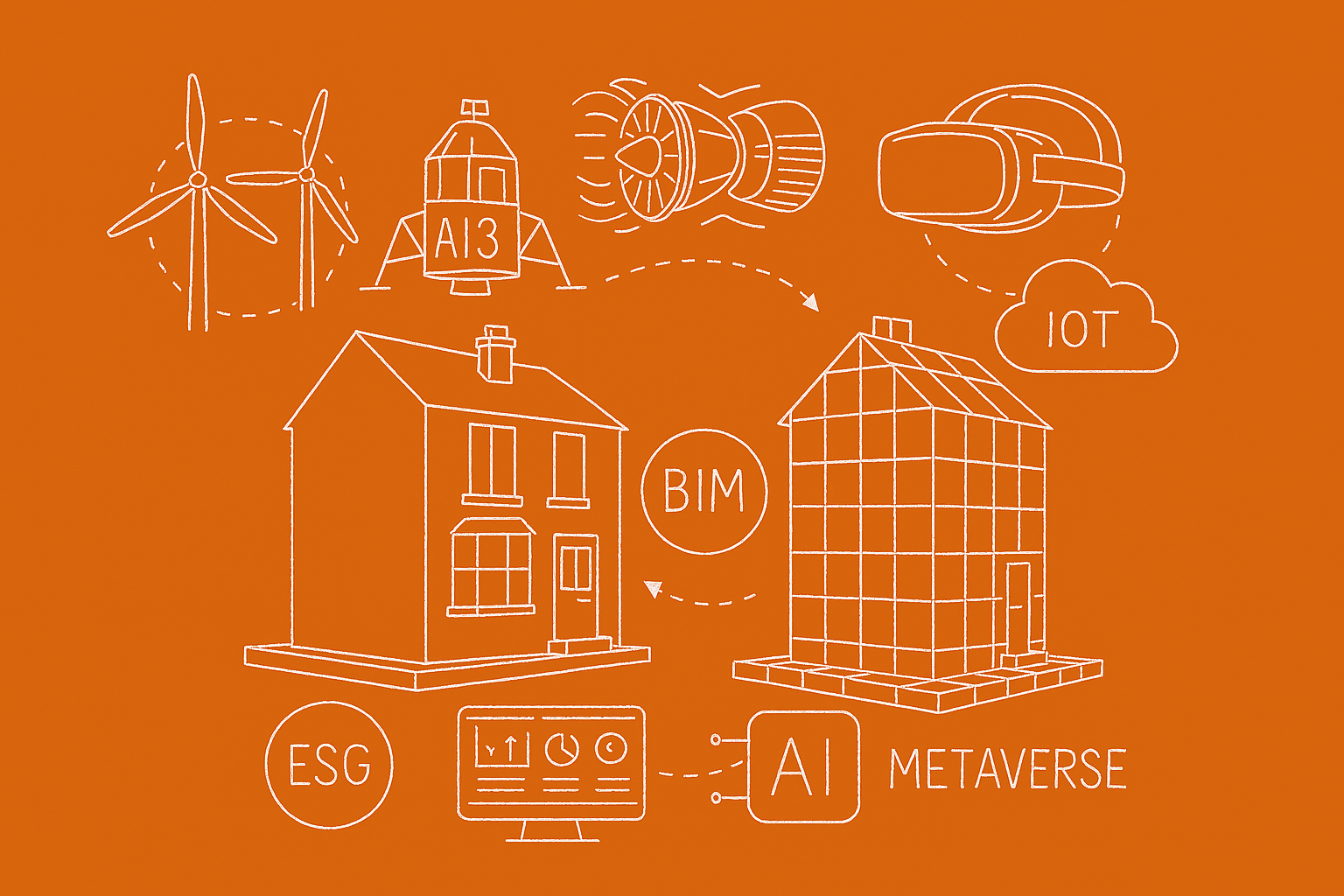Rise of the Digital Twin

Let’s talk Digital Twins. The term has been thrown around a lot recently, especially in the last couple of years. There are many misconceptions about what they are and how they’re used, particularly in the real estate sector. In this article, we’ll explore their history, early use cases, different classifications, potential applications in real estate, and how they may develop in the future.
A Brief History
The history of digital twins is somewhat clouded, going by a range of names or terms. A precursor to the modern version arose in the 1970s, particularly through NASA’s work during the Apollo programme. During the Apollo 13 crisis, engineers mirrored the systems on the stricken capsule to help solve critical issues affecting the crew, ultimately saving their lives.
The foundational concept of the Digital Twin was developed by Michael Grieves, then affiliated with the University of Michigan, as part of his work on Product Lifecycle Management (PLM) around 2002–2003. Grieves described it as the virtual representation of a physical product that follows it from design through operation to disposal, emphasizing synchronization and data exchange between the real-world object and its digital counterpart. While Grieves laid the conceptual groundwork, the actual term “Digital Twin” was later coined by John Vickers of NASA, who collaborated with Grieves to articulate and popularize the idea within aerospace and advanced engineering contexts.
With the rise of the Internet of Things (IoT), cloud computing, and big data analytics in the late 2000s and 2010s, digital twins found a place in industry, academic research, and especially large-scale manufacturing.
Early Applications
Early uses of digital twins were asset-centric, focusing on jet engines, spacecraft, and turbines—pioneered by companies such as General Electric, Rolls-Royce, and Siemens. They were also adopted in high-stakes environments like aerospace, nuclear, and oil and gas.
By integrating real-time operational data with advanced sensing and PLM systems, digital twins enabled predictive maintenance, performance tuning, and anomaly detection. In manufacturing, they became central to virtual commissioning—testing and optimising production lines and robotic systems virtually before physical changes were made. This dramatically reduced downtime, errors, and risk.
Common Misconceptions
Despite their growing prevalence, digital twins remain widely misunderstood:
Not just 3D models
A BIM or CAD file is not a digital twin unless it integrates real-time data from its physical counterpart.
Not dependent on VR/AR
Immersive visualisation can enhance them, but many operate through dashboards or APIs.
Not all equally “smart”
Their intelligence depends on the richness of data streams, sensor integration, and analytics.
Not limited to simulations
Simulations explore hypothetical scenarios, while digital twins reflect the current state and enable two-way interaction.
Not prohibitively expensive
Advances in IoT, cloud platforms, and SaaS solutions have made them accessible to smaller organisations and new sectors, including residential living.
Types of Digital Twins
Digital twins vary in scope and complexity:
Component Twin
A digital representation of a single part (e.g., a turbine blade), used for design optimisation and maintenance.
Asset Twin
Models an entire machine or device, enabling equipment monitoring and predictive maintenance.
System/Unit Twin
Aggregates multiple assets into a subsystem (e.g., a production line), supporting process optimisation.
Process Twin
Captures entire workflows, including interactions between assets and controls, for efficiency and bottleneck analysis.
Network Twin
Large-scale models of interconnected systems, used for supply chain optimisation, urban modelling, and beyond.
Applications in Real Estate and Architecture
Residential
Smart home optimisation (energy use, occupancy, appliance health), security monitoring, and elderly care through real-time data sharing with caregivers.
Commercial
Facility management (HVAC, lighting, occupancy), tenant experience personalisation, and sustainability tracking (carbon footprint, energy efficiency) for ESG.
Student Living
Space utilisation, predictive maintenance, emergency planning, and behavioural insights to improve services.
Transport and Mobility
Digital twins can model and optimise transport systems linked to residential life, enabling smarter mobility planning, real-time parking and EV charging management, synchronised public transport, safer pedestrian/cycling routes, and community-level emissions tracking to support sustainable living.
Architecture and Engineering
Digital twins support the full building lifecycle—from design and construction through operation—by enabling virtual prototyping, clash detection, structural monitoring, and performance optimisation. They allow architects and engineers to test scenarios, improve sustainability outcomes, and ensure designs translate accurately into the built environment.
These applications are still in their infancy, with vast potential yet to be realised.
AI and Digital Twins
AI augmentation is one of the most promising frontiers. By analysing real-time data streams, AI can:
• Predict failures and recommend interventions.
• Optimise processes dynamically.
• Use generative models to simulate and design future states, from industrial systems to climate-resilient urban planning.
Digital Twins and the Metaverse
The convergence of digital twins with the Metaverse opens new possibilities:
Remote operations
Maintenance teams can inspect and interact with equipment virtually, from anywhere.
Collaborative planning
Teams can meet inside a digital twin, manipulating assets in real time.
Training and education
Engineers and builders can safely practice skills in realistic, immersive environments.
Conclusion
From their roots in NASA’s Apollo missions to their role in manufacturing, healthcare, urban management, and residential living, digital twins have evolved into dynamic bridges between the physical and digital worlds.
Their ability to contextualise and analyse real-time data—augmented by AI and immersive technologies—positions them as critical enablers of efficiency, sustainability, and personalisation. Yet misconceptions and hype risk obscuring their true value.
As adoption deepens across sectors, digital twins will expand from asset-focused tools to human-centric and city-scale systems, becoming part of the invisible infrastructure that underpins next-generation solutions.